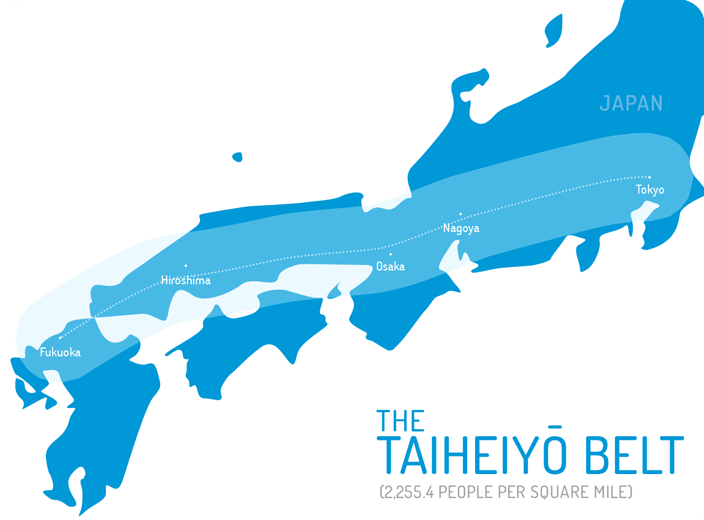What if your urban hipster lifestyle was not in a city of 5 million people? Or even 10 million people? How would a hipster define "urban" in a mega-urban-agglomeration of nearly 3 billion people stretching nearly 12,000 kilometres from its northern to southern suburbs? Would you want to be right in the centre of that urban sprawl or would outer suburban fringe dwelling be more suited for you?
Welcome to the future cities of Asia! Indeed, we may be misleading you already. A process of hyper-urbanisation is already underway across Asia. If that development continues at its current pace and depth it would inevitably lead to the entire urbanised population of Asia coalescing into one contiguous mega-urban-region that will hug the Pacific rim from Beijing in the North to Jakarta in the South. It will be the greatest city mankind has ever known.
A whole range of deeply embedded structural factors are colliding across Asia resulting in a process that can only be described as 'hyper-urbanisation'.
"These powerful forces that show no signs of abating include demographics, globalisation, disruptive digital technologies, changes in state-society relations and the coalescing of populations around transnational supply chains increasingly extending deeper and further into South and Southeast Asia."
These factors individually and in combination have one consequence – urbanisation.
The process of urbanisation has been and will continue to be inseparable from Asia's ongoing economic century. Urbanisation and growth go perfectly together in an economic sense: through history no country or region has ever reached middle-income status and then successfully traversed the 'middle-income trap' without a significant population shift into cities. Whereas in western history this population shift has been more organic, in the more modern history of Asia it has generally been guided by the state. This process of state guidance is both shortening population shifts, but also providing a stronger “multiplier" for when the economic benefits of urbanisation become apparent across society.
The process of urbanisation is itself a sub-set of the economic processes of "modernisation" and "industrialisation". ANZ has focussed on these two developments in two recent in-depth research pieces, "Myanmar: Asia's Uncut Gem" and "ASEAN: The Next Horizon" both of which postulated the process of modernisation and industrialisation in Southeast Asia and the Mekong in particular is likely to be unusually truncated.
In terms of causality, urbanisation leads to industrialisation – the structural transformation that allows low-income agrarian economies dominated by rural populations to move into city-based populations focussed on manufacturing and exports, typically labour-intensive in the first instance.
Industrialisation then becomes the foundation of a more profound multi-dimensional economic transformation of "modernisation" – the management of demographic transitions via the establishment of strong centralised bureaucratic governance, an education system that deepens the skill set of existing workers and children and the acquisition of and means to utilise new technologies. Economies that industrialise can easily attain middle-income status, however modernisation becomes essential for an economy to reach high-income status.
Economies that industrialise can easily attain middle-income status, however modernisation becomes essential for an economy to reach high-income status.
"Again, urbanisation is the absolute critical ingredient. A spatially concentrated population in cities has easier access to jobs and job search opportunities whilst governments can provide services such as education and healthcare much more cheaply and efficiently to urbanised populations."
Given these benefits, it is no surprise then that Asia is urbanising, industrialising and modernising at the fastest pace we have seen in history. For instance, London took 130 years to grow from one to eight million, Bangkok only took 45 years, Dhaka 37 years and Seoul only 25 years. The dramatic increase in Asia's urbanisation rate from around 47 per cent in 2014 to over 66 per cent by 2050 is thus likely to be the largest and fastest single rural to urban human migration event in all of history.
City planners already use the term Megalopolis – a chain of roughly adjacent metropolitan areas which eventually fuse into one contiguous urban area to describe mega-cities and it is a term we expect to increasingly hear to describe Asia. The term Megalopolis was first introduced in 1954 to describe the chain of metropolitan areas along the northeastern seaboard of the United States from Boston to Washington – the BoWash Megalopolis, which is home to over 50 million people.
A megalopolis of roughly the same geographical size, but twice the population, exists in Japan, from Tokyo to Oita – the Taiheiyo Belt, a megalopolis with a population of over 100 million people.


But even the Taiheiyo Belt will come to seem like a village compared to the fusion of mega-urban expected to occur down the asian continental seaboard over the next two-to-three decades. As remarkable as it sounds, the entire 12,000 kilometre sea board from Beijing in the north, to Subaraya in the east of the Indonesian archipelago is likely to fuse into one mega urban region – an urban agglomeration without historical precedent, and one that is very difficult to imagine will ever be matched anywhere else in the world again.
Indeed, the term Eperopolis – a city that occupies a continent – may become increasingly appropriate to use to describe Asia's urban sprawl in the future. Asia - is already in a process of hyper-urbanisation that will demand radical new paths in energy efficiency, de-carbonised growth, the abandonment of private transport for public transport, a complete break-down in the work/life demarcation and the complete submission of distance and geography to digital. That hyper-urbanisation is borne out by the pace at which cities are forming in Asia and growing into mega-cities and then morphing into mega-urban regions.










